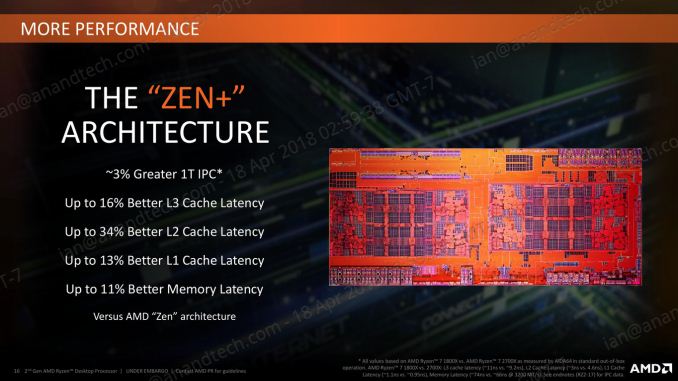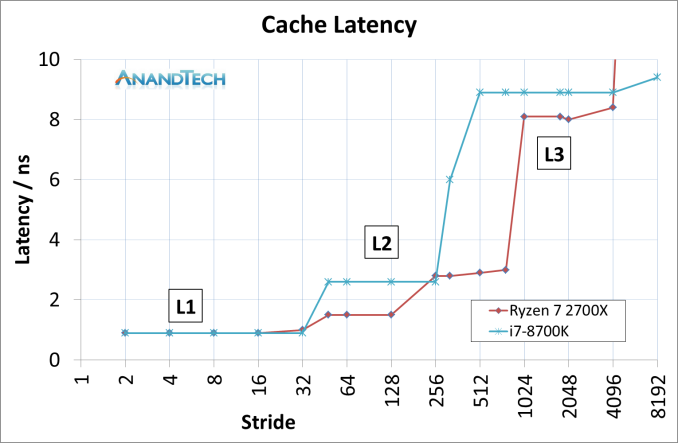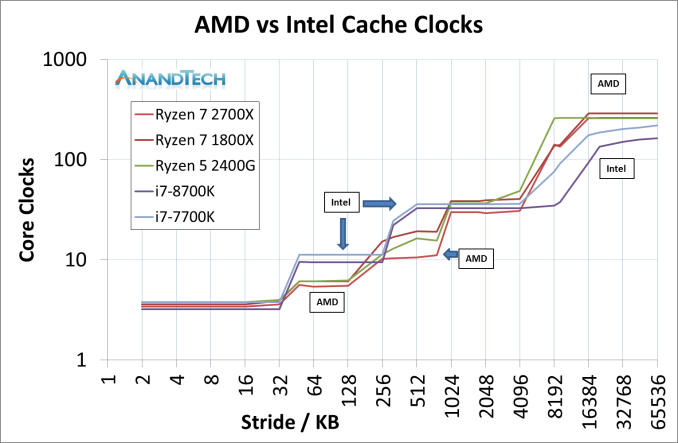The AMD 2nd Gen Ryzen Deep Dive: The 2700X, 2700, 2600X, and 2600 Tested
by Ian Cutress on April 19, 2018 9:00 AM ESTImprovements to the Cache Hierarchy
The biggest under-the-hood change for the Ryzen 2000-series processors is in the cache latency. AMD is claiming that they were able to knock one-cycle from L1 and L2 caches, several cycles from L3, and better DRAM performance. Because pure core IPC is intimately intertwined with the caches (the size, the latency, the bandwidth), these new numbers are leading AMD to claim that these new processors can offer a +3% IPC gain over the previous generation.
The numbers AMD gives are:
- 13% Better L1 Latency (1.10ns vs 0.95ns)
- 34% Better L2 Latency (4.6ns vs 3.0ns)
- 16% Better L3 Latency (11.0ns vs 9.2ns)
- 11% Better Memory Latency (74ns vs 66ns at DDR4-3200)
- Increased DRAM Frequency Support (DDR4-2666 vs DDR4-2933)
It is interesting that in the official slide deck AMD quotes latency measured as time, although in private conversations in our briefing it was discussed in terms of clock cycles. Ultimately latency measured as time can take advantage of other internal enhancements; however a pure engineer prefers to discuss clock cycles.
Naturally we went ahead to test the two aspects of this equation: are the cache metrics actually lower, and do we get an IPC uplift?
Cache Me Ousside, How Bow Dah?
For our testing, we use a memory latency checker over the stride range of the cache hierarchy of a single core. For this test we used the following:
- Ryzen 7 2700X (Zen+)
- Ryzen 5 2400G (Zen APU)
- Ryzen 7 1800X (Zen)
- Intel Core i7-8700K (Coffee Lake)
- Intel Core i7-7700K (Kaby Lake)
The most obvious comparison is between the AMD processors. Here we have the Ryzen 7 1800X from the initial launch, the Ryzen 5 2400G APU that pairs Zen cores with Vega graphics, and the new Ryzen 7 2700X processor.
This graph is logarithmic in both axes.
This graph shows that in every phase of the cache design, the newest Ryzen 7 2700X requires fewer core clocks. The biggest difference is on the L2 cache latency, but L3 has a sizeable gain as well. The reason that the L2 gain is so large, especially between the 1800X and 2700X, is an interesting story.
When AMD first launched the Ryzen 7 1800X, the L2 latency was tested and listed at 17 clocks. This was a little high – it turns out that the engineers had intended for the L2 latency to be 12 clocks initially, but run out of time to tune the firmware and layout before sending the design off to be manufactured, leaving 17 cycles as the best compromise based on what the design was capable of and did not cause issues. With Threadripper and the Ryzen APUs, AMD tweaked the design enough to hit an L2 latency of 12 cycles, which was not specifically promoted at the time despite the benefits it provides. Now with the Ryzen 2000-series, AMD has reduced it down further to 11 cycles. We were told that this was due to both the new manufacturing process but also additional tweaks made to ensure signal coherency. In our testing, we actually saw an average L2 latency of 10.4 cycles, down from 16.9 cycles in on the Ryzen 7 1800X.
The L3 difference is a little unexpected: AMD stated a 16% better latency: 11.0 ns to 9.2 ns. We saw a change from 10.7 ns to 8.1 ns, which was a drop from 39 cycles to 30 cycles.
Of course, we could not go without comparing AMD to Intel. This is where it got very interesting. Now the cache configurations between the Ryzen 7 2700X and Core i7-8700K are different:
| CPU Cache uArch Comparison | ||
| AMD Zen (Ryzen 1000) Zen+ (Ryzen 2000) |
Intel Kaby Lake (Core 7000) Coffee Lake (Core 8000) |
|
| L1-I Size | 64 KB/core | 32 KB/core |
| L1-I Assoc | 4-way | 8-way |
| L1-D Size | 32 KB/core | 32 KB/core |
| L1-D Assoc | 8-way | 8-way |
| L2 Size | 512 KB/core | 256 KB/core |
| L2 Assoc | 8-way | 4-way |
| L3 Size | 8 MB/CCX (2 MB/core) |
2 MB/core |
| L3 Assoc | 16-way | 16-way |
| L3 Type | Victim | Write-back |
AMD has a larger L2 cache, however the AMD L3 cache is a non-inclusive victim cache, which means it cannot be pre-fetched into unlike the Intel L3 cache.
This was an unexpected result, but we can see clearly that AMD has a latency timing advantage across the L2 and L3 caches. There is a sizable difference in DRAM, however the core performance metrics are here in the lower caches.
We can expand this out to include the three AMD chips, as well as Intel’s Coffee Lake and Kaby Lake cores.
This is a graph using cycles rather than timing latency: Intel has a small L1 advantage, however the larger L2 caches in AMD’s Zen designs mean that Intel has to hit the higher latency L3 earlier. Intel makes quick work of DRAM cycle latency however.














545 Comments
View All Comments
invasmani - Sunday, April 22, 2018 - link
I'd prefer they test EQ at 480p...that is the future!GreenReaper - Wednesday, April 25, 2018 - link
Why stop at VGA? Benchmark 240p video rendered in 80-bit x87 algorithms!eva02langley - Monday, April 23, 2018 - link
"Doing say 4K benchmarks would just make people think it doesn't matter which CPU you have and all are the same for gaming"Well, you are totally right on the first part, they don't matter much. Resolutions are just exploding and 4k will become the new standard when the new console generation is going to be released. That means 2160p will become the norm and GPU bottleneck will be even more present than it is right now. Right now the only way to have CPU bottleneck is using a 1080 GTX at 1080p. Not a single sane person would spend that much for rendering 1080p especially for running LoL, Fortnite, WoW, DOTA, CS or RL.
And by the way, we are fighting over result having +- 5% difference in gaming benchs at 1080p. A storm in a glass of water.
Fallen Kell - Wednesday, April 25, 2018 - link
Well, unless Nvidia and/or AMD has a GPU which is 2-4x faster than what they currently have up their sleeves and can manufacture and sell it for only around $150, the next generation consoles will not be 4K resolution, but simply up-scaled 1080.DARK_BG - Saturday, April 21, 2018 - link
On computerbase.de review tighter timings gave the ryzen between 3% and 14% positive increase in game titles FPS on the same RAM frequency alone.Melting the difference with 8700K runing the same memory config in the range 3% to 9 % difference in Intel's favor :) Who says ram config does not matter :)MDD1963 - Saturday, April 21, 2018 - link
So days later, still no answer as to why only AnandTech has such a "Great Disparity" in gaming results compared to...well, everyone? (Can't they double check just the 2700X and 8700K in a few key games in something under 4 days?) :)Ryan Smith - Saturday, April 21, 2018 - link
We've been working on it since Thursday and we'll have a proper, detailed analysis for you guys next week.=)MDD1963 - Saturday, April 21, 2018 - link
:) (Thank you, SIr!)Mugur - Sunday, April 22, 2018 - link
Did the numbers suffer changes? ;-) If not, you are going to start a revolution on the internet... :-)StrangerGuy - Sunday, April 22, 2018 - link
Techreport outright says 8700K actually did better after the Meltdown/Spectre patches in Cinebench, but it's OK, you can always dream.